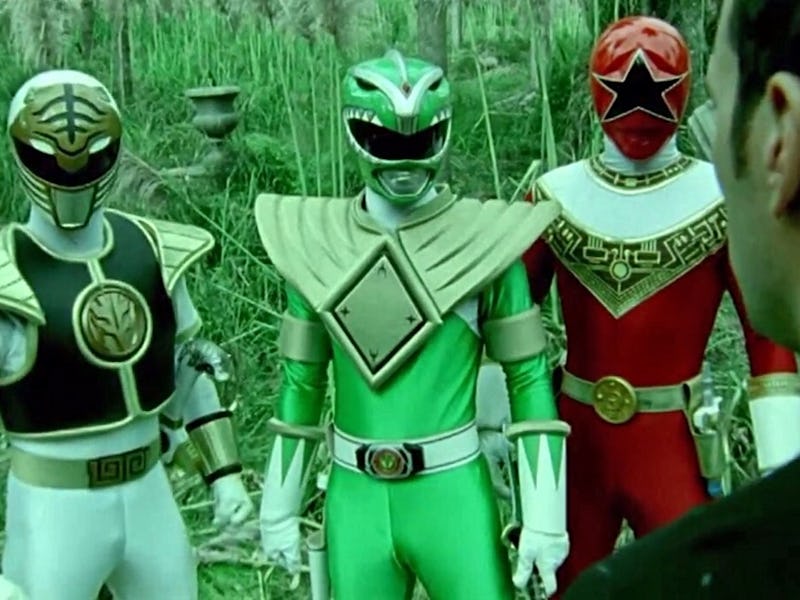Superheroes, From 'The Flash' To 'Batman', Have Fascinating Dream Sequences
Do superheroes dream of super-powered sheep?

Waking up in his bedroom lit by morning sun, Barry Allen (Grant Gustin), also known as the super speedster The Flash, began this week’s episode “inside” the Speed Force. The aura that gives Barry his quick legs took on a physical form in the ethereal plane to challenge Barry and determine whether he’s worthy of becoming Flash again.
Elegantly directed by slacker/auteur Kevin Smith (Clerks, Chasing Amy) and written by X-Men: First Class scribe Zack Stentz, “The Runaway Dinosaur” of DC’s The Flash is an emotional gut punch that still feels tender days later. It will be remembered as one among the best the superhero genre can offer. But the expressionist, Dickensian episode is of another sub-genre that isn’t so prevalent in superhero TV, though it sports a steady track record of being pretty damn good. I’m describing superhero dream episodes.
Like bottle episodes (characters stuck in a room), “Groundhog Day” episodes (characters repeat the day), or “Die Hard” episodes (characters in a hostage situation), there’s a familiar structure to “dream episodes” despite the relatively few examples.
There’s even fewer in superhero shows, but when superheroes do snooze, their predisposition for disturbed mental profiles leave them to endure fierce examinations of their psyches. Meanwhile, in the real, woke world, their allies are often left defenseless to the enemy. Because plot.
In The Flash, a zombified big guy terrorizes S.T.A.R. Labs like an ‘80s horror monster, all while Barry reads his favorite bedtime story with his mommy. It’s quite emotional, actually, but strip away the poetic dialogue and exceptional performances and that was basically what happened.
When costumed crime fighters sleep, their episodes end up outstanding. Their superpowers are no match for their own fears and anxieties. But besides the Flash, have others succumbed to illusionary REM? And how have they played out?
“Fighting Spirit,” Power Rangers Dino Thunder
Directed by Paul Grinder and written by Jackie Marchand, “Fighting Spirit” was one such example of a superhero dream episode in Power Rangers Dino Thunder, the twelfth iteration of the kid’s TV and toy franchise.
Paleontologist and ex-Power Ranger Dr. Tommy Oliver, played by Jason David Frank reprising his role from 1993’s *Mighty Morphin’ Power Rangers, has grown up from a teenager with attitude into the new team’s mentor (and high school science teacher) while also fighting as the new Black Ranger. But in “Fighting Spirit”, Dr. Oliver slips into a coma when an experiment goes wrong.
While the Rangers try to save the city from a rampaging monster, Tommy’s coma becomes a fight for his life when he’s challenged by his older Ranger identities. After fighting his Red and White Rangers, his final and most difficult brawl is against his oldest persona, the evil Green Ranger. Of course Tommy succeeds, and goes on to save the day, but the love-letter episode that was “Fighting Spirit” caught fans way off guard who loved seeing their favorite Ranger’s old costumes again.
“For the Girl Who Has Everything,” Supergirl
The first season of Supergirl wasted no time diving into comics lore. Adapting Alan Moore’s celebrated Superman comic “For the Man Who Has Everything,” the Supergirl adaptation “For the Girl Who Has Everything” saw Kara (Melissa Benoist) under a comatose state from an alien parasite, Black Mercy.
While Kara’s friends try to kill the parasite before it sucks the life out of her (quite literally), Kara has an illusion in which her home planet Krypton was never destroyed and she was never left alone in the universe.
At first airing, I didn’t think highly of “For the Girl Who Has Everything,” but seeing how this storyline advances her relationship with her adoptive sister Alex (Chyler Leigh) makes it far better in hindsight and Kara’s loneliness in the universe far more profound.
“Perchance to Dream,” Batman: The Animated Series
Operatic in tone and sweeping in scope — even for a cartoon (a cartoon that won four Emmy Awards) — “Perchance to Dream” is an outstanding installment in the outstanding Batman: The Animated Series.
One day, out of nowhere, Bruce Wayne (voiced by Kevin Conroy) wakes up in a world in which he never became Batman and his parents, Thomas and Martha Wayne, are still alive. At first in disbelief, Bruce embraces it all and lets himself sink into the illusion — until he forces himself to shake free.
In a climactic fight with “Batman,” Bruce discovers who is behind the plot. When all is said and done and Commissioner Gordon asks him how he came under, Batman, in his signature brood, laments: “The stuff dreams are made of.”
Did Bruce actually believe the dream? Or rather, did he want to? “Perchance to Dream” is one of many fan-favorite episodes and was discussed at length in The Arkham Sessions, a Batman podcast that analyzes the DC character from a psychologist’s perspective.
“Failsafe,” Young Justice
Directed by veteran DC animator Jay Oliva and written by Nicole Dubuc, “Failsafe” from the first season of Young Justice is structurally different from the aforementioned episodes but is no less effective. Minor spoilers ahead.
During a fierce alien invasion, the sidekick superheroes who make up Young Justice band together to become the world’s only defense force. One by one the world’s superheroes, their mentors, are taken out, and the world falls into disarray when mere teenagers with superpowers feel dwarfed by an overwhelming enemy.
Turns out, it’s just a simulation: The un-winnable scenario resembling the Kobayashi-Maru was designed by Martian Manhunter to teach the young heroes how to respond in absolutely worst case scenarios. But young Megan, a.k.a. Miss Martian, demonstrates extremely powerful psychic levels that ominously sends chills down the Martian Manhunter’s spine.
Gripping and overwhelming, Young Justice quickly reminds its viewers that its protagonists are just kids playing a game that maybe, just maybe, they have no business being in.